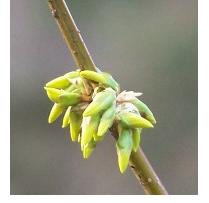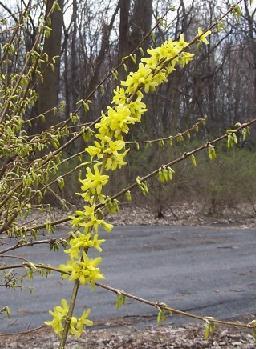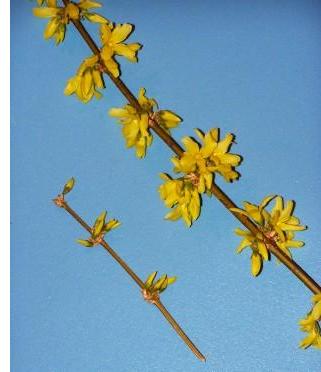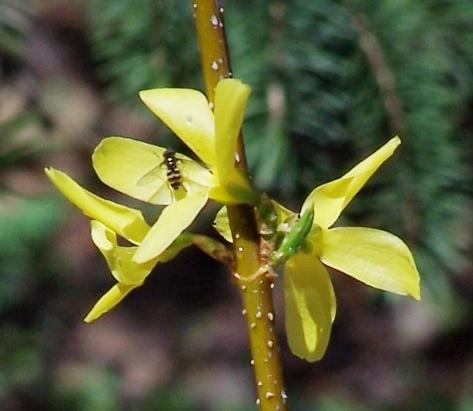
Forcing Forsythia Branches to Flower Indoors in Winter
by Grandpa Cliff 18 Apr 2006, rev. 1 Jan 2007
All photos by Grandpa Cliff

[4/16/06]
[This webpage contains one activity and two experiments.]
In Winter, some people get anxious for Spring to arrive. They wish to see some flowers in bloom. In my area of New York State, the Forsythia bush begins to flower about early- to mid-April. Near the end of February, it is possible to cut a branch of a Forsythia bush and force it to bloom indoors. It might be done even earlier in some states.
Outdoors, Forsythia is a bush on which the yellow flowers appear before any leaves are seen. They are one of the earliest blooming plants. On warm days, they provide nectar for some insects. The leaves begin to appear as the first flowers are withering. Soon only the leaves remain, and the branches begin to lengthen.
Most people trim their bushes at some point. I do it only once a year, about the end of May. If you look closely at the photo above, you can see the rounded shape that the bush had the previous Summer. The branches that stick out beyond the rest of the bush give it an appealing wild look. It is those long branches that can be forced to flower indoors.
Bushes that are kept neatly trimmed during the growing season will not have branches suitable for this project, and they probably won't flower very well. At some point in the growing season, the flower buds for the following Spring develop. Trimming them off results in bush that will have few flowers in the next year. Forsythia is a deciduous bush; it loses its leaves in Autumn. The buds on it will be small overwinter, but they get more plump as Spring nears.

The yellow Forsythia petals are beginning
to emerge from these flower buds.
Guidelines for Making Forsythia Branches Bloom Indoors
1) Remove the branch (or several branches) when the temperature has been above freezing for two or three days, if possible. The warm weather will help the buds expand a bit, and plump buds open sooner.
2) A branch that is removed shortly before the normal flowering date may have its flower buds start opening in a couple of days. Generally speaking, the farther it is from the natural blooming date, the longer the branch will take to bloom indoors.
3) Forsythia branches are hollow. The cut should be made on a diagonal, not straight across the branch. Pruning shears are safe to use. Or, let an adult remove the branch with a sharp knife. A diagonal cut will increase the surface area through which water can be absorbed. Dip the end of the branch in water very soon after removing it from the shrub. That will prevent air from entering the tiny tubes in the cut end. The air can stop water from entering.
4) Using a hammer, hit the cut end of the stem just hard enough to make some breaks in the last inch or two. That will increase the absorbing area even more. The earlier the cutting is removed from the bush, the more helpful these breaks will be. Another way to accomplish the same thing is to make some vertical cuts at the cut end with pruning shears. Caution: Some websites recommend that you take a sharp knife and make slices up the cut end (1-2" long). However, Forsythia stems are tough, and using a knife this way is dangerous. You should never cut toward any part of your body, especially a finger or hand. Such cuts can be safely made with pruning shears. Otherwise, use a hammer. Get the stem into water quickly.
5) The cutting can be put directly into a vase if outdoor blooming is only a week or two away. It is best kept quite cool for a day so that the cutting does not have to adjust to a big temperature change. Then, bring it into a warmer part of the house. It should be kept out of direct sunlight. Any buds that are below water should be removed. If you don't, they will be food to bacteria and cause the water to foul.
6) Cuttings taken long before the outdoor flowering date will have smaller buds that have to grow before they can open. The process will start more quickly if most of the branch is kept underwater for 24 hours or so (in a cool area). This will help the entire stem absorb more water, which will allow the buds to start developing sooner. If your branch is long, you may not be able to find a way to put most of it underwater. In that case, fill a pale nearly full of water and stand the stem vertically for about three days in a cool area. Remove it from the water, and put it in a wide vase or wide-mouthed jar until the flowers develop. Any buds that are below water should be removed. If you don't, the bacteria will grow. Once the flowers begin opening, you can transfer the stem to any vase you wish.
7) Change the water every few days to decrease bacterial growth, or use a flower preservative (see the recipe below for making your own).
8) Cut the bottom inch off the branch once a week.
![]()

A branch was forced to bloom indoors. Since the buds were almost ready to open, it took only three days for the flowers to appear. It was then photographed next to the bush from which it came (see left photo). You can see the dramatic difference.

In the close-up photo at the right, the same branch is shown next to a branch cut from the bush on the day the photo was taken.
![]()
EXPERIMENT #1 - Taking a cutting each week
About 6 weeks before the natural flowering time, remove a branch. Remove another branch of about the same size 5 weeks before, another 4 weeks before, another 3 weeks before, 2 weeks before, and 1 week before. Treat all branches the same way. Label the first container 6, the second one 5, etc.
Notes are important to scientists. In a notebook, record the treatment you will give each cutting. Record the date each cutting was made. Record the size and appearance of the buds on the branch when each cutting is made. For each cutting, record when you notice the first bit of yellow on some of the buds. For each cutting, record when the first petals appear, when the first full flower appears, and when all of the flowers have opened. For each cutting, calculate how many days it took from the day you removed the branch, to the day the first full flower appeared. Also, calculate the number of days from the cutting date to the date the branch was in full bloom. Record anything else you think is worth mentioning. Keep these notes in a safe place for use in future years.
From these observations, you will be able to determine when it is probably the best time to take Forsythia cuttings. Does cutting 6 bloom any earlier than cuttings 5 and 4? Does it bloom earlier than 3 and 2? If the answer is no to any of these questions, there is no sense in making cuttings so early. Draw some conclusions and write them in your notebook.
![]()
EXPERIMENT #2- Taking all cuttings at the same time
About 3 weeks before natural flowering time, take four cuttings, one right after the other. Immediately, dip the cut ends in water. From the "Guidelines for Making Forsythia Bloom Indoors" above, use steps 1-5. Use the diagonal cut, but don't use the hammer or pruning shears to make extra breaks or cuts in the stem.
All four cuttings should be treated exactly the same way except as noted below. They should be in the same room so that they will be exposed to the same temperature. Don't have one branch near a heat source and the others far away. They should all receive abouth the same amount of indirect sunlight. An experiment varies certain things that are being tested. Everything else in an experiment should be the same for each cutting.
Flower Preservative
Homemade mixes can be as effective as commercial preservatives. 1 teaspoon sugar |
Cutting #1. Leave this cutting in its container of aged tapwater until the end of the experiment. Add aged tapwater when needed.
Cutting #2. Same as with #1, except that once a week you will remove the bottom inch or two from the cut end. Pruning shears work very well. Let a parent supervise all cutting if a knife is used.
Cutting #3. Leave this cutting in its container of homemade flower preservative until the end of the experiment. Add homemade flower preservative when needed.
Cutting #4. Same as #3, except that once a week you will remove the bottom inch or two from the cut end. Pruning shears work very well. Let a parent supervise all cutting if a knife is used.
In a notebook, keep dated notes about what you did and what happened along the way. At the end, draw some conclusions. Did removing the end of a cutting periodically help or not? Did it help in both containers? Did the homemade flower preservative help or not? Did it help in both containers?
Notes:
1) To make aged tapwater, find a clean pail (no leftover detergents should be in it). Fill it with water. Let it set for three days to allow the chlorine to escape.
2) Using aged tapwater, you will need to make more than a quart of homemade flower preservative. The amount you make will depend on the size of your containers, how much water the plant will use to grow its buds and flowers, and how much water will evaporation from the container. An extra quart or quart and a half should be enough to resupply all of the water which disappears from the containers.
3) The extra aged water and the extra flower preservative should be stored in covered containers.
4) The flower preservative solution contains sugar for nutrition, bleach to keep the water clear of bacteria, and citric acid to gently acidify the water. If bacteria get too abundant, they may plug the microscopic "tubes" at the cut end of the branch and thereby prevent water intake. Using flower preservative and occasionally cutting off the cut end of the stem are two methods of preventing the build-up of bacteria.
![]()
You can try forcing branches of other flowering bushes to see if they will work. Many do, including Spiraea. If you recognize pussy willow before the buds open, I believe it would work also. Online, I found the following plants mentioned as good for forcing blooms indoors: flowering cherry, flowering plum, witch hazel, flowering crab apple, winter jasmine, flowering quince, and lilac. After removing any of the woody branches, they should be split vertically for an inch or more (see notes above, and let a parent supervise the splitting).
![]()

This branch was in a vase which I took outdoors in order to get a close-up of the flowers and the green leaf bud. The spots on the stem are lenticels through which stems can get oxygen from the air. I wasn't outside long before an insect landed on a petal, no doubt attracted by one of the few food sources available in mid-April. When you look at the insect, you will see what looks like a bee. However, if you look closely you will see only two wings. Though hard to believe, it is a fly (bees have four wings). It is thought that it resembles a bee so that other animals, such as predators, won't bother it or try to eat it.
![]()
Rose Bowl Parades in Pasadena, California use Forsythia flowers to provide some of the yellow color on the motorized floats. During the 2007 parade it was mentioned that there are no Forsythias in bloom in January, but that the flowers are forced to bloom. I saw clusters of full branches as pictured above on this webpage, but they mentioned that some yellow flowers were individually threaded into place. I believe they were single Forsythia flowers that had been removed from their branches.
![]()
Visitors since 30
Dec 2006
Go to Grandpa Cliff's Science Website for Teenagers (HOME)
Albany, NY